

Compact Muon Solenoid
LHC, CERN
| CMS-PAS-HIN-19-002 | ||
| Measurement of the elliptic flow of Υ(1S) and Υ(2S) mesons in PbPb collisions at √sNN= 5.02 TeV | ||
| CMS Collaboration | ||
| November 2019 | ||
| Abstract: The second-order Fourier coefficients (v2) characterizing the azimuthal dependence of Υ(1S) and Υ(2S) mesons arising from PbPb collisions at √sNN= 5.02 TeV are determined. The Υ mesons are reconstructed using the di-muon decay channel as measured using the CMS detector. The dataset was obtained in 2018 and corresponds to an integrated luminosity of 1.7 nb−1. The scalar product method is used for the v2 analysis. Results are reported for the rapidity range |y|< 2.4, with 0 <pT< 50 GeV, and in four centrality classes of 0-10%, 10-30%, 30-50% and 50-90%, with 0-10% corresponding to the most central collisions. The average v2 value for Υ(1S) mesons is 0.007 ± 0.011 (stat) ± 0.005 (syst) in the 10-90% centrality interval. The observed v2 values are consistent with zero for all pT and centrality ranges, with a maximum offset of 2.5 standard deviations. The v2 value for Υ(2S) mesons is measured for the first time and found to be -0.063 ± 0.085 (stat) ± 0.037 (syst) in the 10-90% centrality interval. | ||
|
Links:
CDS record (PDF) ;
CADI line (restricted) ;
These preliminary results are superseded in this paper, PLB 819 (2021) 136385. The superseded preliminary plots can be found here. |
||
| Figures | |
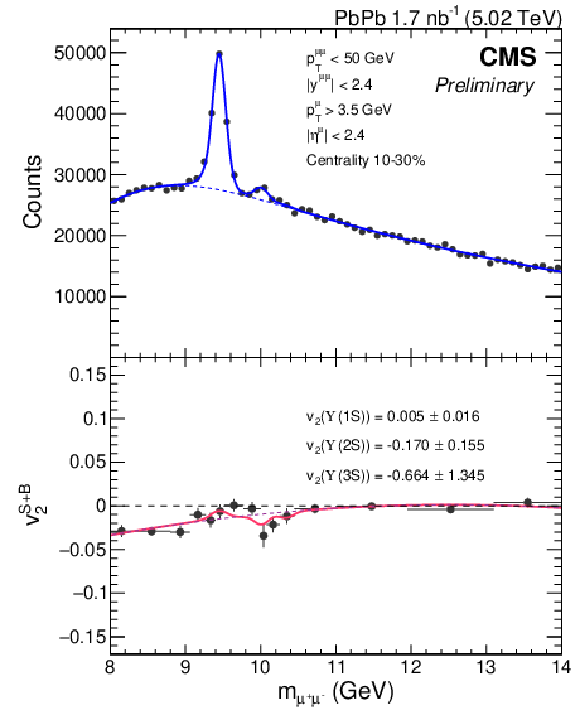
png pdf |
Figure 1:
Simultaneous fit of the dimuon invariant mass spectrum and the vS+B2 distribution, as defined in Eq. 3, for pT< 50 GeV and with centrality 10-30%. The solid (signal + background) and dashed (background only) blue lines show the result of the mass fit, and the solid and dashed red lines show the corresponding results for the fit to the v2 distribution. |
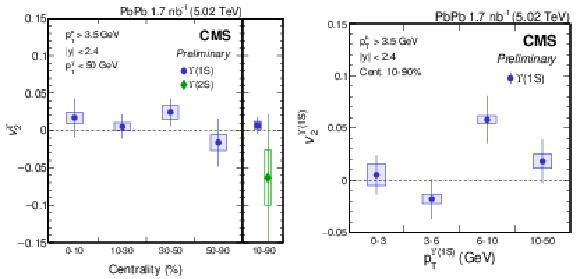
png pdf |
Figure 2:
(Left) pT integrated v2 values for Υ(1S) mesons measured in four centrality bins and for the Υ(2S) meson in the 10-90% centrality range. (Right) v2 as a function of pT in the 10-90% centrality range. All results are for the rapidity range of |y|< 2.4. The vertical bars denote statistical uncertainties, and the rectangular bands show the total systematic uncertainties. |
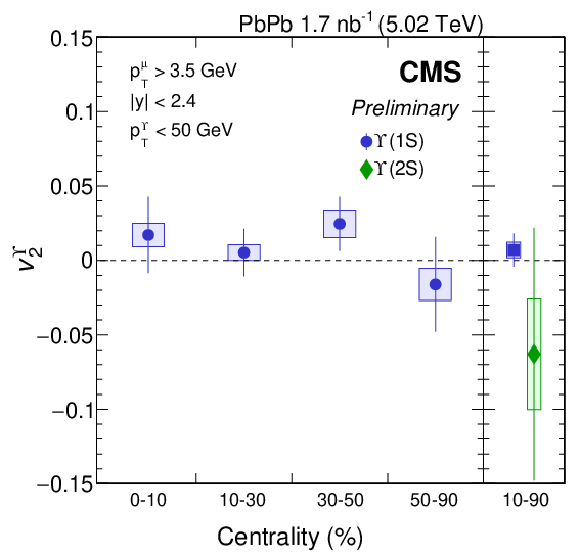
png pdf |
Figure 2-a:
pT integrated v2 values for Υ(1S) mesons measured in four centrality bins and for the Υ(2S) meson in the 10-90% centrality range. |

png pdf |
Figure 2-b:
v2 as a function of pT in the 10-90% centrality range. All results are for the rapidity range of |y|< 2.4. The vertical bars denote statistical uncertainties, and the rectangular bands show the total systematic uncertainties. |
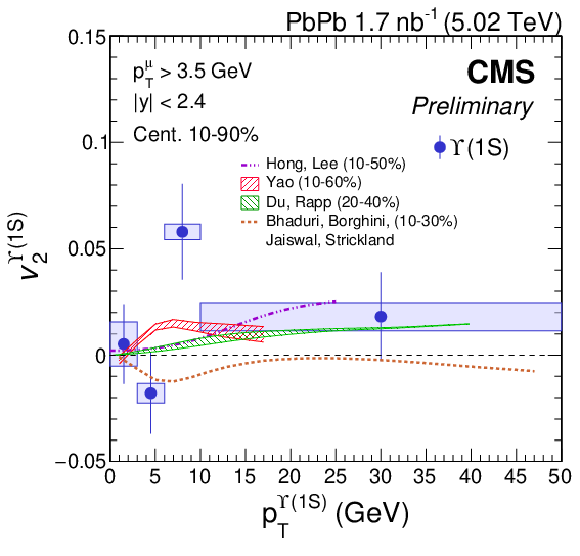
png pdf |
Figure 3:
The green shaded area (Du, Rapp [29]) shows the results of a model calculation using the kinetic-rate equation to simulate the time evolution of bottom quarks. In this model, the medium effect is applied with a lattice-QCD based equation of state. The red band (Yao [30]) is the result of a real-time simulation of heavy quarks using coupled Boltzmann transport equations. The dashed violet line (Hong, Lee [31]) is the calculation with the potential Non-Relativistic QCD (pNRQCD) theory. In this approach, a diffusion constant D(2πT)= 6 was used to have the derived RAA value being consistent with the CMS result in Ref. [8]. The dashed brown line (Bhaduri, Borghini, Jaiswal, Strickland [32]) shows the results of using a 3+1d aHydro model. The calculations provide the QGP temperature evolution with the initial conditions and shear viscosity to entropy density ratio tuned to LHC 5.02 TeV identified hadron spectra and flow harmonics. |
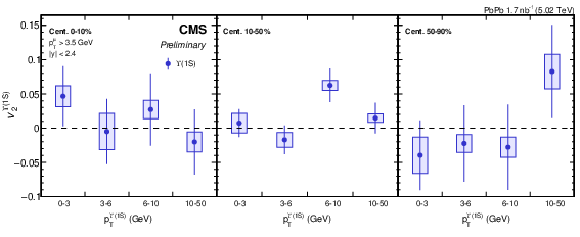
png pdf |
Figure 4:
v2 coefficients for Υ(1S) mesons as a function of pT in three centrality bins: 0-10% (Left), 10-50% (Middle) and 50-90% (Right). The rapidity range is |y|< 2.4. The vertical lines indicate the statistical uncertainties and the rectangular bands show the total systematic uncertainties. |
| Summary |
| In summary, the elliptic flow coefficient v2 for Υ(1S) and Υ(2S) mesons are measured for |y|< 2.4 in PbPb collision at √sNN= 5.02 TeV. Results are reported for the rapidity range |y|< 2.4, with 0 <pT< 50 GeV, and in four centrality classes of 0-10%, 10-30%, 30-50% and 50-90%, with 0-10% corresponding to the most central collisions. The v2 values found for Υ(1S) mesons are consistent with zero over the kinematic range studied, within a maximum of 2.5 standard deviations. This observation contrasts with the measured J/ψ v2 results in PbPb collisions [13,14], suggesting different medium effects for charmonia and bottomonia. The data are compared to several theoretical models, all consistent with the results. In addition the first measurement of the elliptic flow coefficient for Υ(2S) mesons in a heavy ion experiment is also reported and the result is consistent with zero. Because the contribution of regeneration to Υ(2S) meson production in PbPb collisions is expected to be different from that of Υ(1S) meson and to occur at a later stage of the collision, this study provides new inputs to the production mechanisms of bottomonia in heavy ion collisions. |
| References | ||||
| 1 | F. Karsch, E. Laermann, and A. Peikert | The Pressure in two flavor, (2+1)-flavor and three flavor QCD | PLB 478 (2000) 447--455 | hep-lat/0002003 |
| 2 | E. V. Shuryak | Theory of Hadronic Plasma | Sov. Phys. JETP 47 (1978) 212--219.[Zh. Eksp. Teor. Fiz.74,408(1978)] | |
| 3 | T. Matsui and H. Satz | J/ψ Suppression by Quark-Gluon Plasma Formation | PLB 178 (1986) 416--422 | |
| 4 | CMS Collaboration | Suppression of Υ(1S),Υ(2S) and Υ(3S) production in PbPb collisions at √sNN= 2.76 TeV | PLB 770 (2017) 357--379 | CMS-HIN-15-001 1611.01510 |
| 5 | ALICE Collaboration | Suppression of Υ(1S) at forward rapidity in Pb-Pb collisions at √sNN= 2.76 TeV | PLB 738 (2014) 361--372 | 1405.4493 |
| 6 | ALICE Collaboration | Υ suppression at forward rapidity in Pb-Pb collisions at √sNN= 5.02 TeV | PLB 790 (2019) 89--101 | 1805.04387 |
| 7 | CMS Collaboration | Suppression of Excited Υ States Relative to the Ground State in Pb-Pb Collisions at √sNN= 5.02 TeV | PRL 120 (2018), no. 14, 142301 | CMS-HIN-16-008 1706.05984 |
| 8 | CMS Collaboration | Measurement of nuclear modification factors of Υ(1S), Υ(2S), and Υ(3S) mesons in PbPb collisions at √sNN= 5.02 TeV | PLB 790 (2019) 270--293 | CMS-HIN-16-023 1805.09215 |
| 9 | STAR Collaboration | Suppression of Υ production in d+Au and Au+Au collisions at √sNN= 200 GeV | PLB 735 (2014) 127--137 | 1312.3675 |
| 10 | PHENIX Collaboration | An Upgrade Proposal from the PHENIX Collaboration | 1501.06197 | |
| 11 | S. Voloshin and Y. Zhang | Flow study in relativistic nuclear collisions by Fourier expansion of Azimuthal particle distributions | Z. Phys. C 70 (1996) 665--672 | hep-ph/9407282 |
| 12 | ALICE Collaboration | Search for collectivity with azimuthal J/ψ-hadrons in high-multiplicity p-Pb collisions at √sNN= 5.02 TeV and 8.16 TeV | PLB 780 (2018) 7 | 1709.06807 |
| 13 | ALICE Collaboration | J/ψ Elliptic Flow in Pb-Pb Collisions at √sNN= 5.02 TeV | PRL 119 (2017) 242301 | 1709.05260 |
| 14 | CMS Collaboration | Suppression and azimuthal anisotropy of prompt and nonprompt J/ψ production in PbPb collisions at √sNN= 2.76 TeV | EPJC 77 (2017) 252 | CMS-HIN-14-005 1610.00613 |
| 15 | CMS Collaboration | Observation of prompt J/ψ meson elliptic flow in high-multiplicity pPb collisions at √sNN= 8.16 TeV | PLB 791 (2019) 172--194 | CMS-HIN-18-010 1810.01473 |
| 16 | ALICE Collaboration | Measurement of Υ(1S) elliptic flow at forward rapidity in Pb-Pb collisions at √sNN= 5.02 TeV | 1907.03169 | |
| 17 | M. Luzum and J.-Y. Ollitrault | Eliminating experimental bias in anisotropic-flow measurements of high-energy nuclear collisions | PRC 87 (2013) 044907 | |
| 18 | CMS Collaboration | The CMS experiment at the CERN LHC | JINST 3 (2008) S08004 | CMS-00-001 |
| 19 | CMS Collaboration | The CMS trigger system | JINST 12 (2017) P01020 | |
| 20 | CMS Collaboration | Description and performance of track and primary-vertex reconstruction with the CMS tracker | JINST 9 (2014) P10009 | CMS-TRK-11-001 1405.6569 |
| 21 | CMS Collaboration | Transverse momentum and pseudorapidity distributions of charged hadrons in pp collisions at √s= 0.9 and 2.36 TeV | JHEP 02 (2010) 041 | CMS-QCD-09-010 1002.0621 |
| 22 | T. Sjostrand, S. Mrenna, and P. Skands | PYTHIA 6.4 physics and manual | JHEP 05 (2006) 026 | hep-ph/0603175 |
| 23 | GEANT4 Collaboration | GEANT4: A Simulation toolkit | NIMA 506 (2003) 250--303 | |
| 24 | I. P. Lokhtin et al. | Heavy ion event generator HYDJET++ (HYDrodynamics plus JETs) | CPC 180 (2009) 779--799 | 0809.2708 |
| 25 | CMS Collaboration | Performance of CMS Muon Reconstruction in pp Collision Events at √s= 7 TeV | JINST 7 (2012) P10002 | CMS-MUO-10-004 1206.4071 |
| 26 | CMS Collaboration | Measurement of prompt D0 meson azimuthal anisotropy in Pb-Pb collisions at √sNN= 5.02 TeV | PRL 120 (2018), no. 20, 202301 | CMS-HIN-16-007 1708.03497 |
| 27 | M. J. Oreglia | A study of the reactions ψ′→γγψ | PhD thesis, Stanford University, 1980 SLAC Report SLAC-R-236, see Appendix D | |
| 28 | Particle Data Group Collaboration | Review of Particle Physics | CPC 40 (2016), no. 10, 100001 | |
| 29 | X. Du, R. Rapp, and M. He | Color Screening and Regeneration of Bottomonia in High-Energy Heavy-Ion Collisions | PRC96 (2017), no. 5, 054901 | 1706.08670 |
| 30 | X. Yao et al. | Quarkonium production in heavy ion collisions: coupled Boltzmann transport equations | PoS HardProbes2018 (2018) 157 | 1812.02238 |
| 31 | J. Hong and S. H. Lee | Υ(1S) transverse momentum spectra through dissociation and regeneration in heavy ion collisions | 1909.07696 | |
| 32 | P. P. Bhaduri, N. Borghini, A. Jaiswal, and M. Strickland | Anisotropic escape mechanism and elliptic flow of bottomonia | 1809.06235 | |

|
Compact Muon Solenoid LHC, CERN |

|

|

|

|

|

|